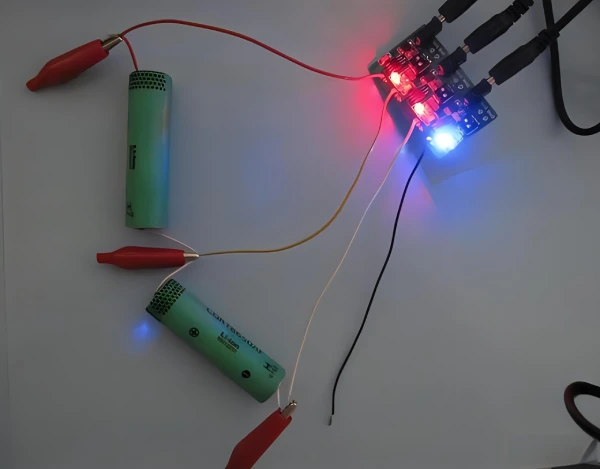A lithium-ion battery lasts for about 3 years and can give 500 charge cycles within that period. It is the battery technology for solar power systems and electric vehicles, among other applications. It is, therefore, understandable that many people would want to know the intricacies of the lithium ion battery charge. Fast charging is a particularly interesting proposition.
The concept of lithium-ion battery fast charge brings several dynamics to the market. Those unsure about the reliability of the electric vehicle, for instance, are excited when they discover that full charge can be achieved within minutes!
This post looks at the science of fast charge for lithium-ion batteries.

Part 1. Lithium-ion battery charging and discharging
Before we look at how to charge a battery fast and discharge a battery, let us review the structure of the battery.
The battery comprises four main components: anode, cathode, separator, and electrolyte. Lithium ions move across the different electrodes through the electrolyte to facilitate the charging and discharging process.
1. What does battery discharge mean?
The lithium-ion battery discharges when a load is connected between the anode and cathode. Energy is consumed as the stored lithium-ion ions transfer from the anode to the cathode.
2. What does battery charge mean?
The charger introduces electric current to the battery during the lithium-ion battery charging process. This triggers the lithium-ion ions (initially at the cathode) to change position to the anode. The resulting potential difference means that the battery is charged.
Part 2. Lithium-ion battery fast charging principle
We often hear news of lithium-ion batteries that can charge within minutes. Battery brands are competing for the fastest charging times. But why is there a craze about lithium-ion battery fast charging? What is the quick charge?
The benefits of fast charging
In an era when every aspect of the economy is fast-paced, traditional hours of charging are no longer viable. Slow charging is associated with operational inefficiencies that affect the business’s profitability.
Faster lithium-ion battery charging is the answer, as it unlocks many opportunities. Consider the enhanced efficiency that comes with this technology. An energy storage system can be deployed in the blink of an eye. Many modern sectors thrive on this energy supply swiftness.
Businesses looking to enhance their sustainability efforts can use the lithium-ion fast charging element with tangible results. Fast charging, together with renewable energy, reduces energy wastage, thus furthering the greening agenda.
What is lithium-ion battery fast charging?
In case you are still wondering, “What does battery discharge mean?” it all boils down to the charge rate. The charge rate is the speed of storing and releasing energy from the battery. This capability is typically called the C rate, with a higher C rate indicating a higher charging rate. The C denotes battery capacity.
The typical charging process for a Lithium-ion battery is initially constant-current (CC). Then it ends with a constant-voltage (CV) status. It can take up to two hours to complete.
Lithium-ion battering fast charging largely follows the same steps but does so within a short time. A full charge can be attained within a few minutes. The latest demonstration of this capability is by a group of engineers from Cornell University, who developed a lithium-ion battery that can charge within five minutes.
Part 3. 3 Charging profiles for lithium-ion battery fast charging
1. Constant Current — Constant Voltage (CC-CV)
The CC-CV profile is easily the most popular for lithium battery charge. It starts with a constant current charging that goes to the voltage cut-off. Then, a phase of constant voltage takes place and lasts until the current approaches zero. A notable advantage of this lithium battery charge profile is the capability to exploit more of the battery capacity within the voltage limit. However, since the current decrease is exponential, the charging time tends to be long.
2. Constant power — constant voltage (CP-CV)
In place of constant current in the first profile, this lithium battery charge profile applies constant power. The charging continues to a set voltage before it remains constant.
3. Multistage Constant Current (MCC)
In this profile, the charging process encompasses a series of constant current phases in decreasing steps. The lithium battery charge process stops when the battery attains the terminal conditions. This profile takes longer than the CC-CV one.
Comparison between slow charging and fast charging
| Feature/element | Slow charging | Fast charging |
|---|---|---|
| Heat generation | Some heat generated | Generates more heat, could overheat |
| Battery life | Usually lasts longer due to less strain on the system | Regular fast charges can cause faster degradation |
| User safety | Less heat means higher safety | Requires up-to-date safety features |
| Charging duration | Takes longer to charge | Takes less charging time |
| System cost | Simpler charging technology translates to general lower cost | Advanced charging equipment can affect the cost |
Part 4. Factors affecting lithium battery charging speed
Several factors affect the charging speed for a lithium-ion battery, including the charger technology, charging current/voltage, and battery temperature.
1. Charger technology
The lithium battery charge market is constantly evolving to meet the demand for faster Lithium-ion battery charging. Users may want to be keen on charger technology, such as the type of semiconductor material used.
2. Charging current and voltage
Higher charging current and voltage speed up the charging process, but charging the battery fast this way could cause overheating.
3. Charging Profile
Generally, charging profiles that start with higher currents are related to faster charging.
4. Battery temperature
High temperature may favor the need to charge the battery fast. Still, it could lead to the damage of the graphite electrodes, consequently causing capacity loss. Extremely low temperatures are not desirable either because they slow the charging speed. Constantly monitor the temperature during charging for the most optimal charging speed.
Part 5. The impact of fast charging on lithium batteries
While fast charging has its place in the present world, it can be a concern because it affects the integrity of lithium-ion batteries. A group of scientists at the Argonne National Laboratory identified one major problem – the graphite particles that make the anode in the batteries tend to attract the lithium ions in a phenomenon called intercalation.
Under normal operating conditions, the charging and how to discharge a battery process is unaffected. However, fast charging promotes the absorption of the ions into the anode, thereby degrading the battery.
Part 6. Summary
Lithium-ion charging technology is pointing in one direction: Charge the battery fast. Users are dealing with modern-day challenges that demand prompt responses, so saving charging time and overall costs makes sense.
Adopting quicker lithium ion battery charge technologies makes an increasingly sustainable future attainable. It requires picking the best charging technology and balancing battery temperature, voltage, and current.
For more tips related to the lithium battery industry, contact us today.
Related Tags:
More Articles

Overview of Deep Cycle Lithium Battery
In this article, we explore the life, voltage, capacity, and charging considerations of deep cycle lithium batteries.
How Long do Lithium Batteries Last?
How long do lithium batteries last? we will explore the factors that influence the lifespan of lithium batteries and provide insights into their longevity.
How to Choose the Best LiFePO4 Battery?
Choose LiFePO4 batteries for superior performance, safety, and versatility in EVs, UPS, and backup power. This guide helps you make informed decisions.
Get 12v Lithium Car Battery As a Power Source for the Ride
Make the right choice for your vehicle's battery needs by installing a 12 volt lithium car battery. You will enjoy maintenance-free longevity with this change.
Everything About A Small Lithium Ion Battery
Discover the features, uses & future potential of a small lithium ion battery. A compact and tiny powerhouse ideal for smartphones, wearables, drones & more.





